You’ll love this easy fettuccine carbonara, made from scratch the traditional way (no cream!). Crispy pancetta (or bacon) and al dente pasta are tossed through a gloriously silky carbonara sauce made with fresh eggs, pecorino cheese and starchy pasta water. And everything is ready in 15 minutes; perfect for a comforting midweek meal.
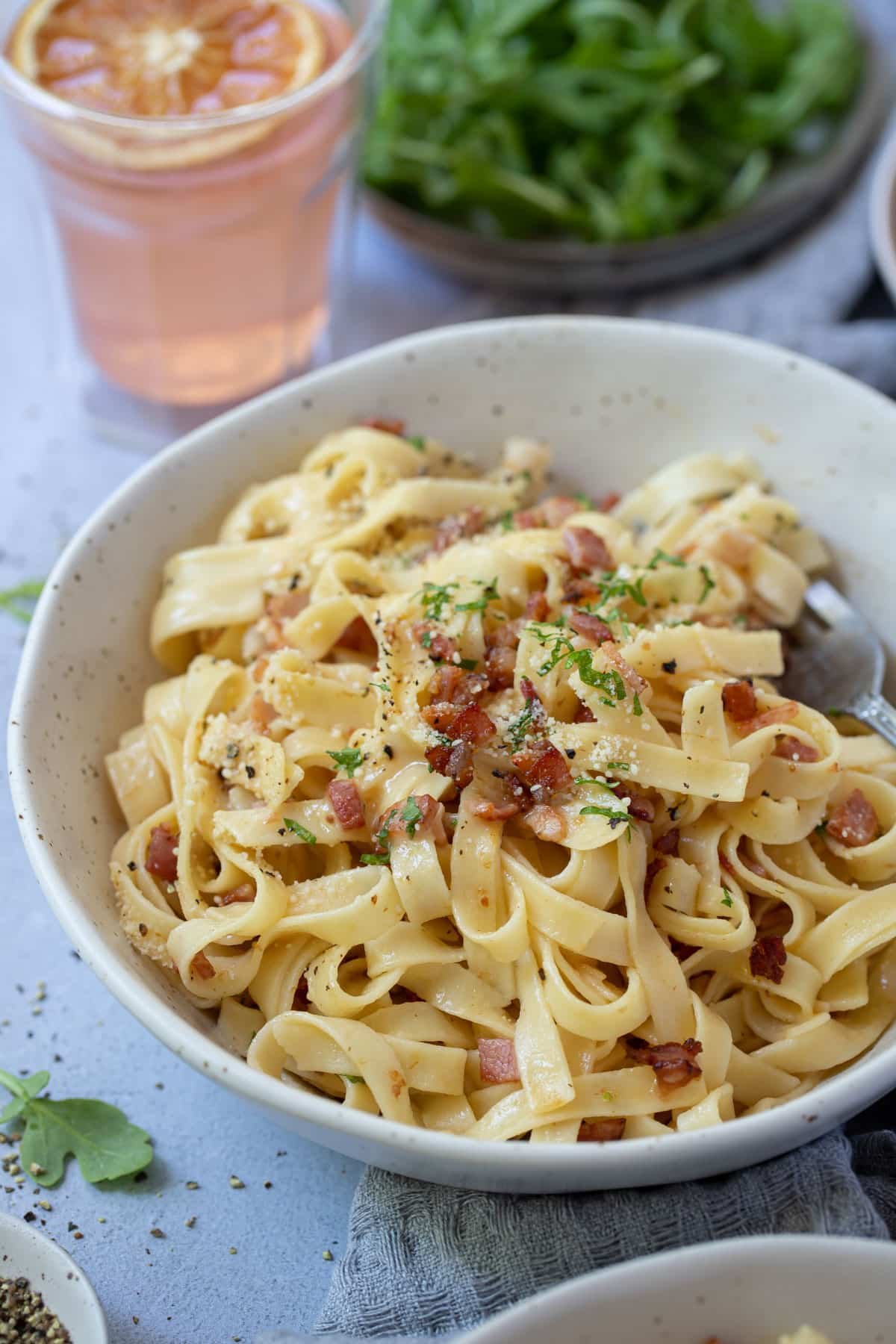
Why you’ll love this recipe
- Easy – carbonara is so simple to make from scratch, with just a handful of basic fridge and pantry ingredients.
- Quick – ready to eat in about 15 minutes, from start to finish. It only takes as long as the pasta takes to cook!
- No cream! – this recipe is made the traditional way (which means no cream). Traditional carbonara gets its creaminess and silky texture from eggs, cheese and starchy pasta water with no added cream.
- Restaurant quality – this is the real deal. Rich, creamy and comforting. Loved by all ages and perfect for a midweek meal, but also super impressive when you’re entertaining!
- So tasty, with minimal effort involved!
- Fool-proof recipe – with step-by-step photos and tips to avoid a curdled sauce, you’ll be making carbonara like a pro!
While we’re on the subject of comforting pasta dishes, you’ll love this creamy sausage pasta and chorizo and prawn pasta!
Ingredients you will need
** This post contains tips and instructions to achieve the best possible results. This photo is a great guide for when you are in the supermarket, but for full ingredient quantities and methods, please scroll down to the detailed recipe card below!

- Fettuccine – this recipe calls for fettuccine, but you can use any type of fresh or dried pasta you prefer. Long strands of pasta like fettuccine, spaghetti or linguine are perfect for clinging to the silky carbonara sauce. If you prefer smaller pasta, use penne or rigatoni. I use Latina fresh egg Fettuccine, but any type of fresh or dried pasta will work. Be sure not to overcook the pasta, or it will become mushy in the sauce.
- Pancetta – a type of Italian-style cured pork, made by salting pork belly. Guanciale is traditionally used in carbonara, but it can be harder to find. Either guanciale or pancetta are best, as they have more fat and flavour, but bacon will also work if you are unable to source them. Choose the best quality, thick-cut meat you can afford, as it will make all the difference in the final flavour.
- Pecorino Romano – hard Italian cheese made from sheep’s milk. It has a sharp flavour (similar to parmesan) and melts into a velvety cream when mixed with hot water. I recommend a good quality pecorino cheese first, but parmesan cheese will work if this is what you have. I use Zanetti Pecorino Romano and it gives the pasta such a lovely flavour. The most important thing is to use fresh cheese that you grate yourself, rather than purchasing pre-grated, packaged cheese. Pre-grated cheese won’t melt into the sauce properly and will clump together, resulting in a runny, lumpy mess.
- Eggs – three large eggs and one yolk add richness and help to create the sauce. Use fresh, room temperature eggs for best results.
- Pepper – use cracked black pepper (not ground pepper).
- Pasta water – liquid gold! In traditional carbonara, the hot, starchy water used to cook the pasta is what transforms the pecorino and eggs into a dreamy, creamy carbonara sauce. Pasta water helps to thin the sauce and hold everything together. It is a key ingredient, so be sure to reserve some before draining the pasta!
Step by step instructions
Full recipe quantities and instructions can be found in the detailed recipe card below.
This recipe uses the Italian method of emulsifying the pasta sauce (mixing the eggs and cheese with the reserved pasta water). This process makes a thick, rich and silky sauce that will cling to every strand of pasta.
Authentic carbonara must be made quickly. Although there are minimal steps, timing is everything. The best way to prepare the perfect carbonara is to follow the recipe to the letter, paying close attention to each step along the way.
1. Cook the fettucine in a large pot of boiling, salted water.
Once the pasta is cooked, don’t forget to reserve 1-2 cups of the starchy pasta water before draining!
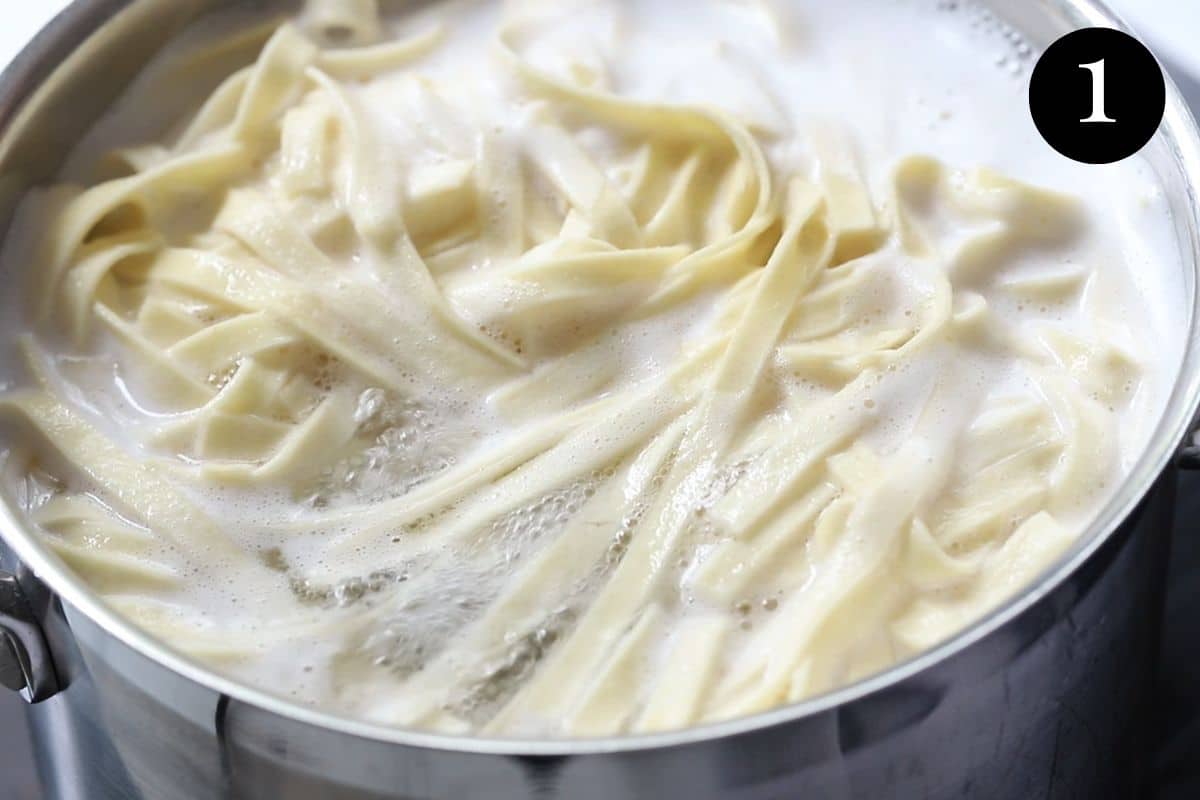
While the pasta is cooking, prepare the sauce ingredients.
2. Make the egg mixture by beating together the eggs, pecorino and cracked pepper. Set aside.
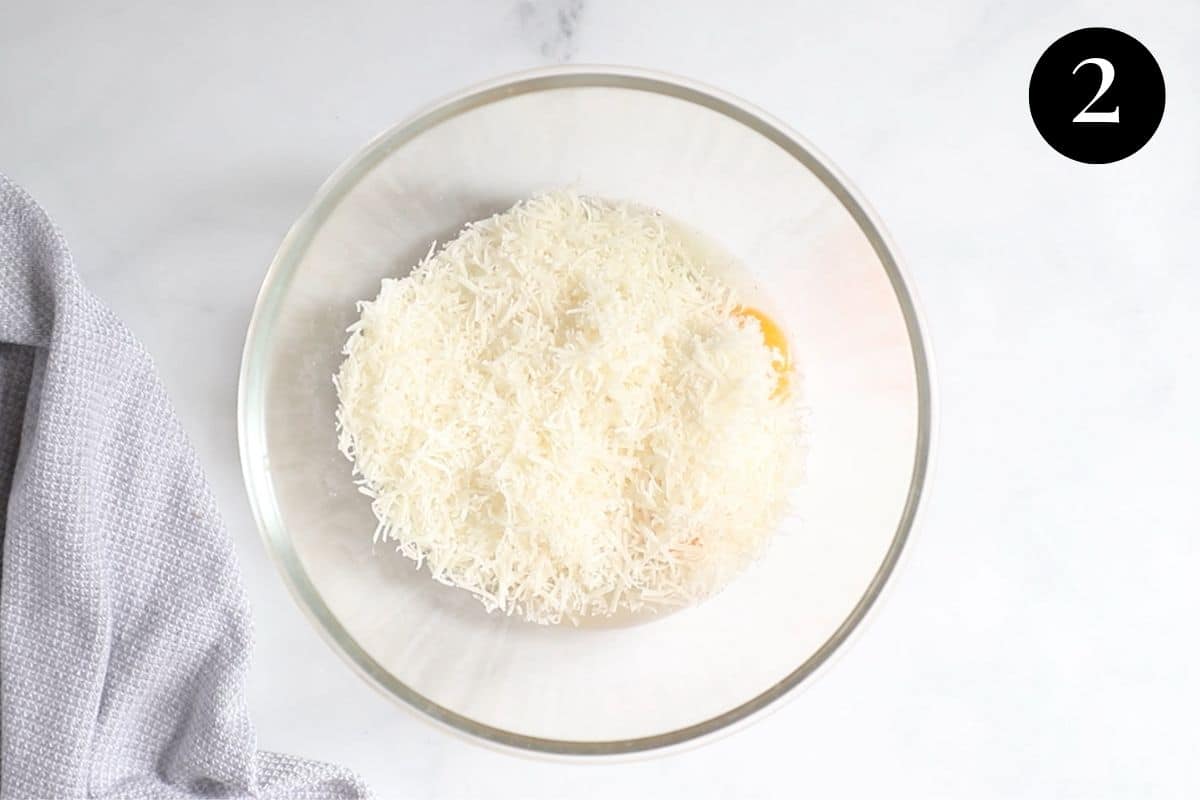
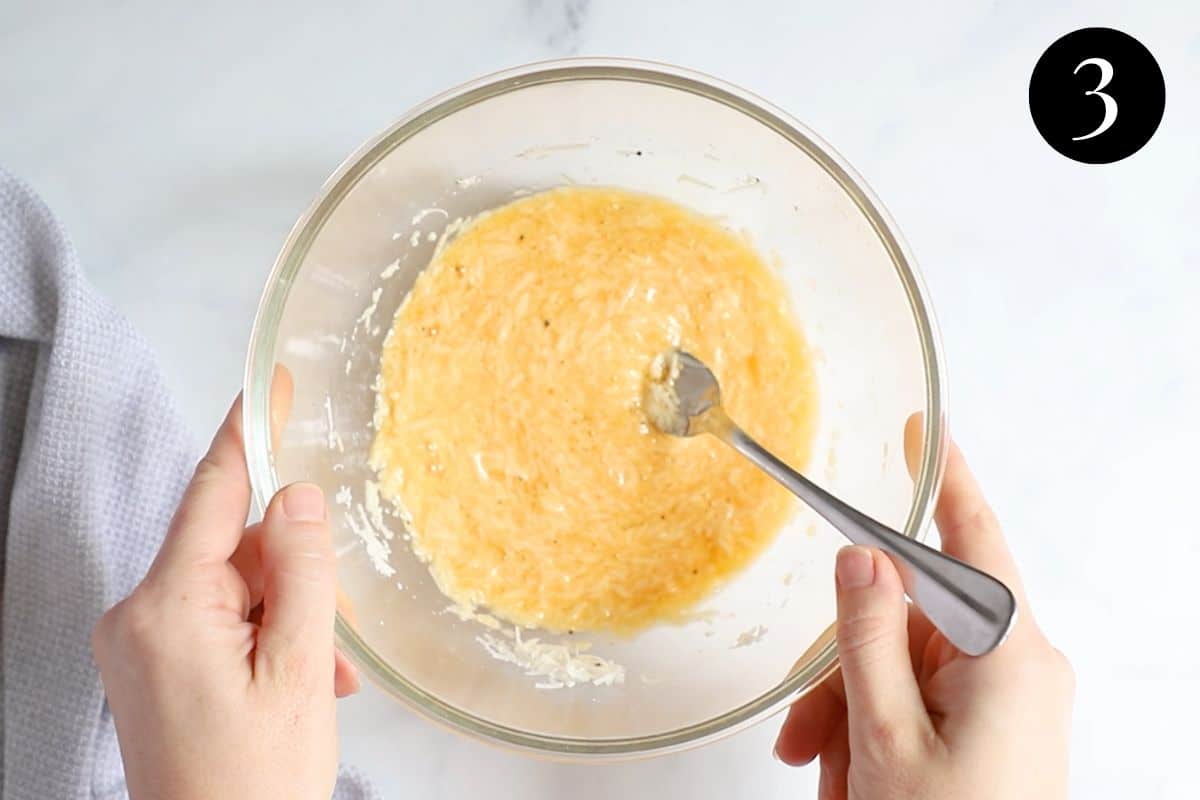
3. Fry the pancetta (or bacon) and garlic in a frying pan with a little olive oil, until crisp.
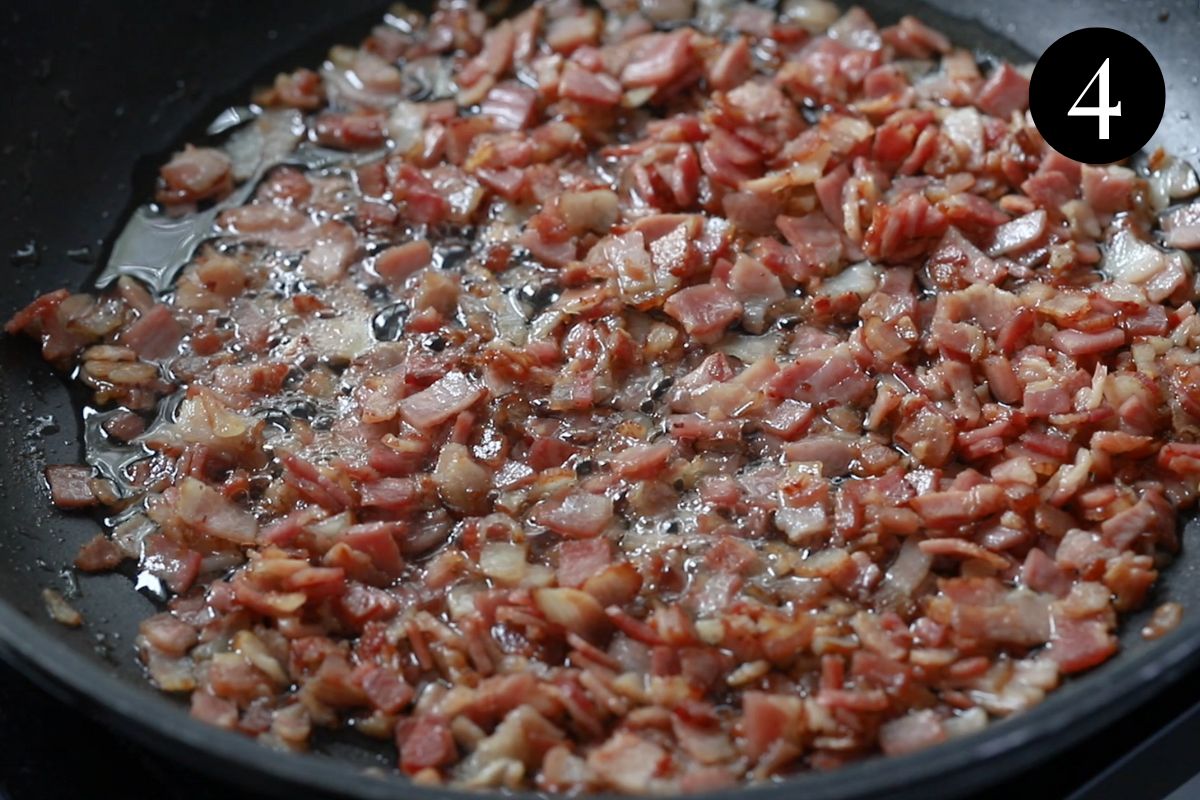
4. Drain the pasta, being sure to reserve 1-2 cups of the pasta water.
You should only need 1 cup of pasta water, but save a little extra in case you need to thin the sauce further.
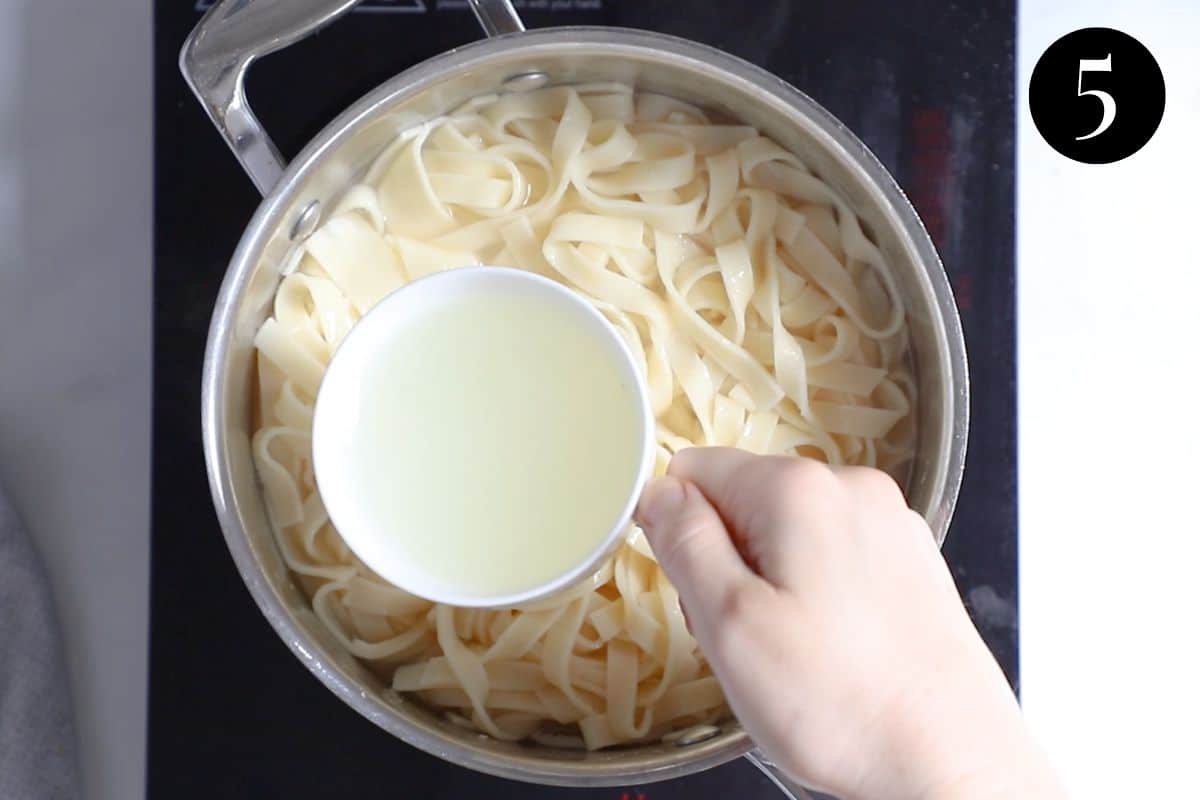
5. With the heat still on, add the drained fettuccine and reserved pasta water to the pan with the pancetta. Stir to coat and then turn the heat off.
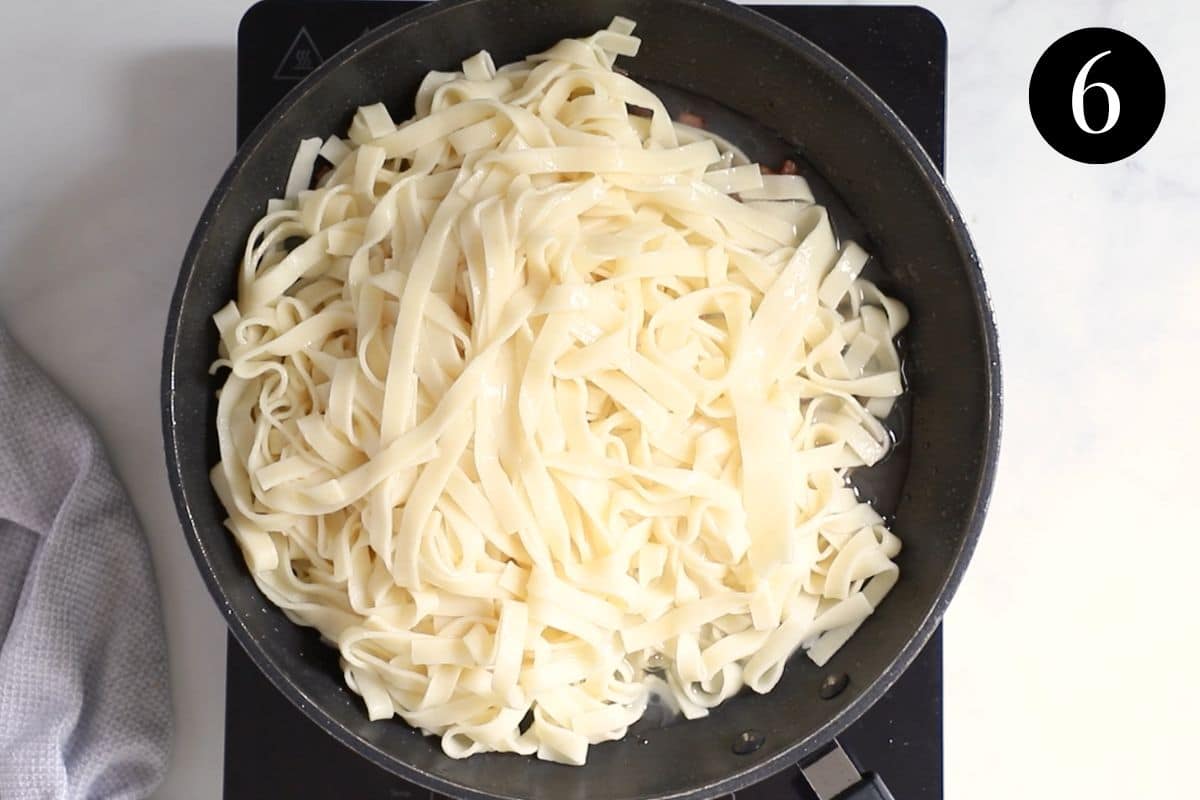
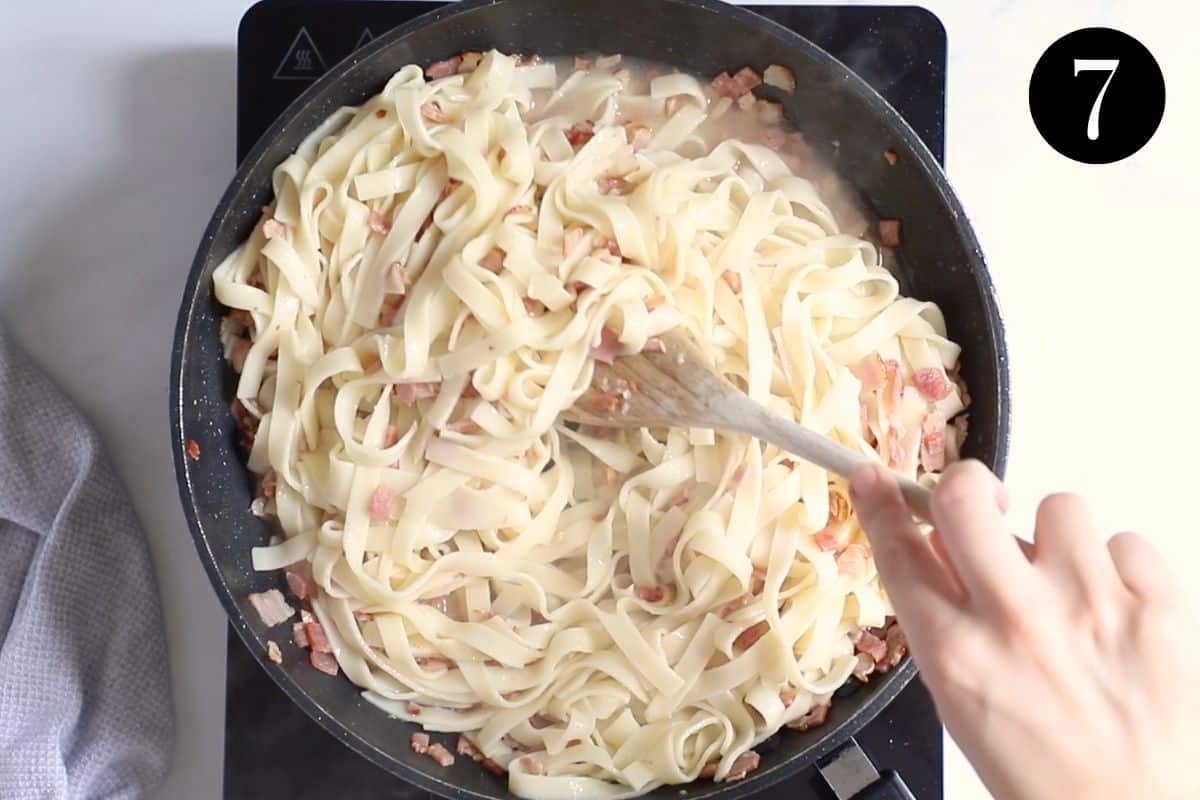
6. Leave the pan to sit for 1-2 minutes (if the pasta is too hot, the eggs will scramble and become lumpy; see notes below).
Add the egg mixture to the pasta. Working quickly, stir the pasta until the egg mixture and pasta water combine and thicken slightly, making a creamy sauce.
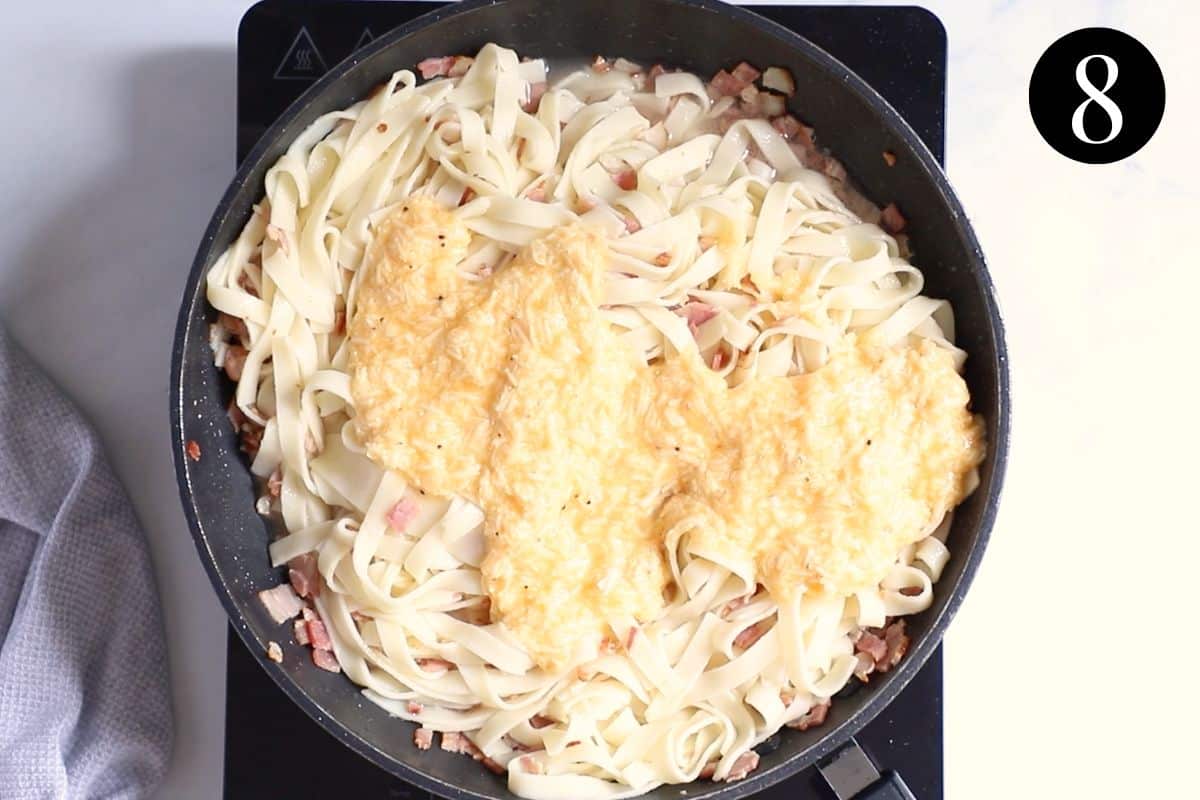
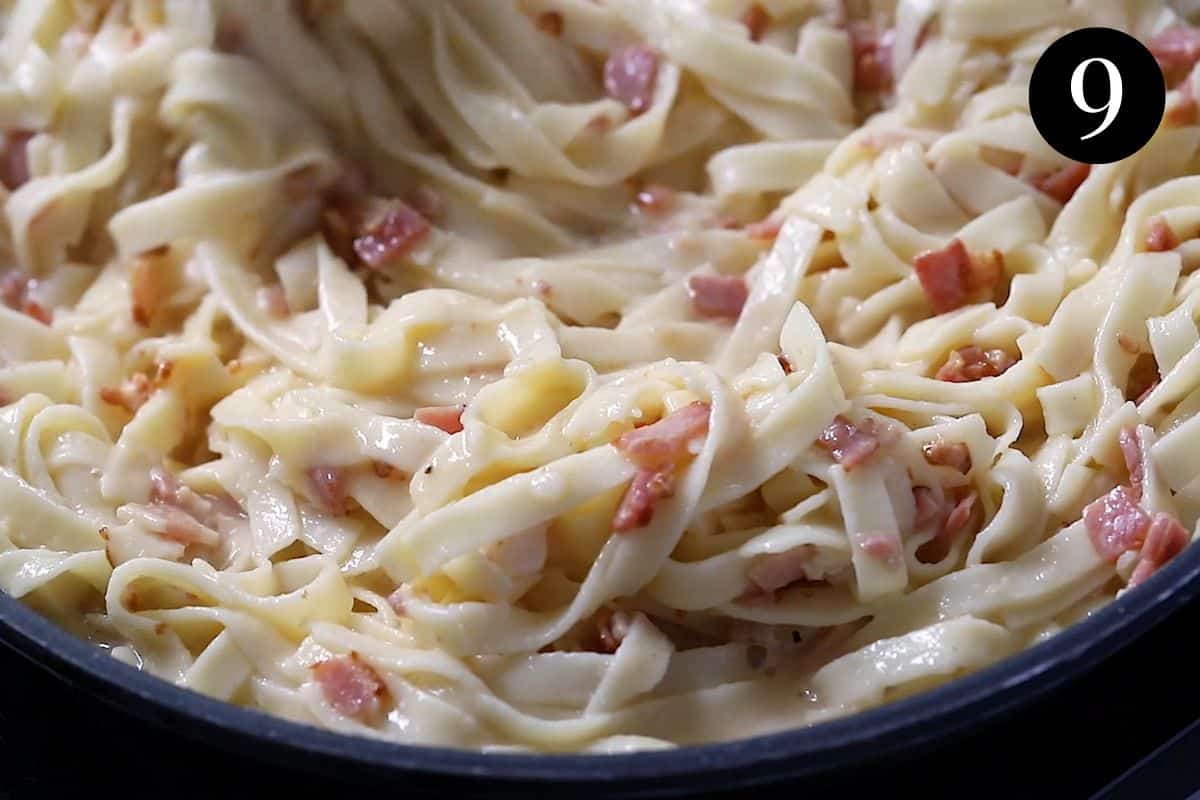
Expert tips
- Don’t forget to reserve the pasta water before draining!
- Turn off the heat before adding the egg mixture. This is the most important step in making carbonara. Adding the eggs with the heat on will scramble the eggs, making an unpleasant and lumpy sauce. After mixing the pancetta and pasta/pasta water, turn the heat off and leave the pan to sit for 1-2 minutes. The residual heat is enough to thicken the sauce, without scrambling the eggs. If the sauce doesn’t quite thicken enough, stir very carefully over low heat for only enough time to thicken and then remove from the heat immediately.
- Work quickly. Have everything prepared and ready to add to the pan before you start to make the sauce. Once you add the eggs to the pasta, quickly stir everything together and keep stirring until the sauce thickens.
- Don’t over-salt! The pancetta, pecorino and pasta water all contain salt, so the pasta is usually perfectly seasoned without the need for extra salt. Save the seasoning to the end and adjust only if necessary.
- Use room temperature eggs. This will help to keep the sauce smooth and light. Cold eggs can become lumpy.
- Freshly grate the cheese. Don’t use pre-packaged shredded cheese. It contains anti-caking agents that will prevent the cheese from melting properly into the sauce. Grate your own fresh cheese so that it incorporates into the sauce.
- Don’t overcook the pasta. Drain the pasta when it is al dente. Overcooked pasta will become mushy and fall apart in the sauce.
- Salt the pasta water. Add 1 tablespoon of salt to 4-5 litres of boiling water. This will season the pasta perfectly from the inside out.
- Variations – add some leftover sliced chicken breast, or add some spinach leaves to the sauce to wilt before serving. Serve it with some crusty herb bread, grilled asparagus, steamed veggies or a side salad for a complete meal.
FAQs
Carbonara is a delicate dish that is best eaten fresh, as soon as it is made. But leftovers can still be stored to enjoy later. Allow it to cool completely and store it in an airtight container in the fridge for up to 4 days.
To reheat carbonara, remove the container of pasta from the fridge and allow to sit at room temperature for up to 30 minutes. When ready to reheat, place the pasta in a large, non-stick pan and add a little stock or water, to loosen. Stir over low heat until steaming hot and serve immediately.
I don’t recommend freezing carbonara. The last-minute combining of the ingredients mean that it is best eaten when freshly made. When frozen, the pasta will become mushy and lose its shape and the egg-based sauce will lose quality.
Carbonara is usually served with fettuccine, spaghetti or linguine, but you can use any type of fresh or dried, short or long pasta that you prefer.
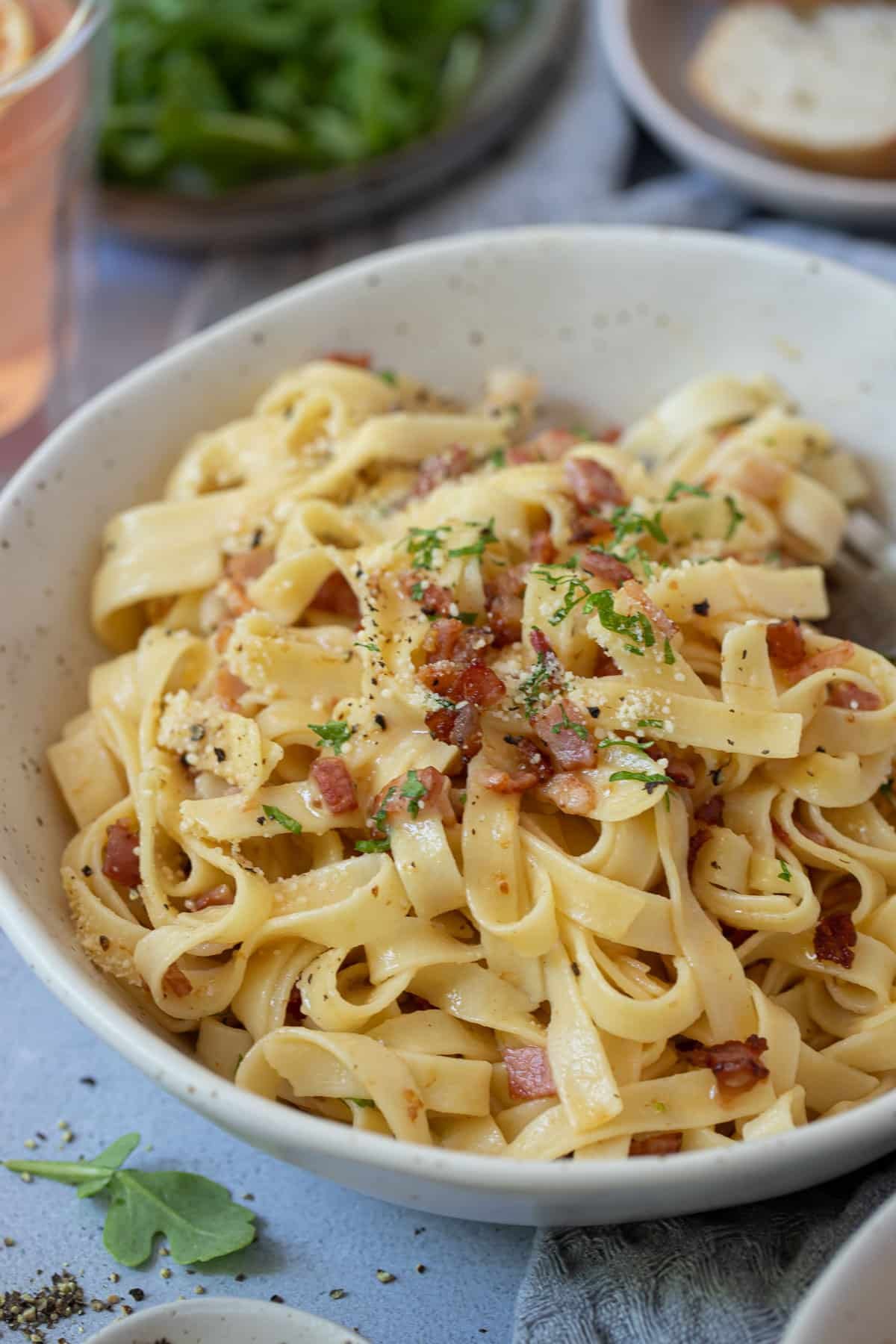
Related recipes
Tried this recipe? Please leave a star ⭐⭐⭐⭐⭐ rating or leave a review below and let me know how you went!
Hungry for more? Subscribe to my newsletter and follow along on Facebook, Instagram and Pinterest for the latest recipes and news.
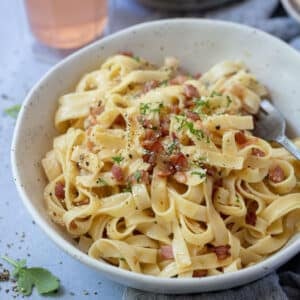
Fettucine Carbonara (No Cream)
Ingredients
- 375 grams fettuccine fresh or dried
- salt for the pasta water
- 3 large eggs room temperature
- 1 egg yolk
- 1 cup Pecorino Romano cheese around 80-90 grams freshly grated pecorino romano. Or use parmesan instead.
- cracked black pepper
- 300 grams pancetta (or bacon) or guanciale or bacon, finely diced.
- 4 cloves garlic crushed
- 2 tablespoons olive oil
- 1 cup reserved pasta water (reserve the salted, starchy pasta water that the pasta is cooked in for the sauce)
To serve
- extra pecorino cheese shaved or finely grated
- cracked pepper
Instructions
- In a large pot over high heat, bring 4-5 litres of water and 1 tablespoon of salt to the boil. Add your pasta and cook to the packet instructions, until the pasta is al dente (don't overcook). Don't forget to reserve at least 1 cup of pasta water before draining the pasta.
- While the pasta is cooking, prepare the ingredients for the sauce.
- Place the eggs, egg yolk, pecorino and some cracked pepper in a bowl and stir until combined. Set aside.
- Add the pancetta (or bacon), garlic and olive oil to a large frying pan and cook over medium-high heat until the pancetta is very crisp and lightly browned.
- Before draining the pasta, reserve one cup of pasta water and set aside. Drain the pasta.
- Add the cooked pasta and reserved pasta water to the pan with the pancetta and stir (over heat) until well combined.
- Turn the heat off and let the pan sit for 1-2 minutes. Turning the heat off is important to prevent the eggs from scrambling. Make sure you have some tongs or a spoon handy for when you add the egg mixture.
- Working quickly, add the egg and pecorino mixture to the pasta and stir or toss together until completely combined. Keep stirring or tossing until the sauce has thickened to a cream-like consistency.
- Serve immediately with some extra pecorino cheese. Enjoy!
Video
Notes
- Don’t forget to reserve the pasta water before draining!
- Turn off the heat before adding the egg mixture! This is the most important step in making carbonara. Adding the eggs with the heat on will scramble the eggs, making an unpleasant and lumpy sauce. After mixing the pancetta and pasta/pasta water, turn the heat off and leave the pan to sit for 1-2 minutes. The residual heat is enough to thicken the sauce without scrambling the eggs. If the sauce doesn’t quite thicken enough, stir very carefully over low heat for only enough time to thicken and remove from the heat immediately.
- Work quickly. Have everything prepared and ready to add to the pan before you start to make the sauce. Once you add the eggs to the pasta, quickly stir everything together and keep stirring until the sauce thickens.
- Don’t over-salt! Save the seasoning to the end and adjust only if necessary. The pancetta, pecorino and pasta water all contain salt, so the pasta is usually perfectly seasoned without the need for extra salt.
- Use room temperature eggs. This will help to keep the sauce smooth and light. Cold eggs can become lumpy.
- Freshly grate the cheese. Don’t use pre-packaged shredded cheese, which contains anti-caking agents that will prevent the cheese from melting into the sauce. Grate your own fresh cheese so that it mixes nicely into the sauce.
- Don’t overcook the pasta. Make sure the pasta is al dente. Overcooked pasta will become mushy and fall apart in the sauce.
- Salt the pasta water. Add 1 tablespoon of salt to 4-5 litres of boiling water. This will season the pasta perfectly from the inside out.
- Variations – add some leftover sliced chicken breast or add some spinach leaves to the sauce to wilt before serving.
- Storage; Carbonara is a delicate dish that is best eaten fresh, as soon as it is made. But leftovers can be stored to enjoy later. Allow it to cool completely and store it in an airtight container in the fridge for up to 4 days.
- Reheating; remove the container of pasta from the fridge and allow to sit at room temperature for up to 30 minutes. When ready to reheat, place the pasta in a large, non-stick pan and add a little stock or water, to loosen. Stir over low heat until steaming hot and serve immediately.
- This recipe yields 4 small or 3 larger serves of pasta. Please note that the nutrition information is based on the pasta being divided into 4 bowls, with one bowl being one serve. The nutritional information is an estimate only and does not take into account any additional toppings or sides served with the pasta.
- This recipe is made using Australian cups and spoon measurements. Any reference to cups or spoons in this recipe is in Australian metric. Due to cup sizes varying from country to country, I advise adjusting if necessary.
Nutrition
Are you following us on Facebook, Instagram and Pinterest?
Update Notes: This recipe was originally published in March 2019, but was re-published with new information and photos in January 2023.


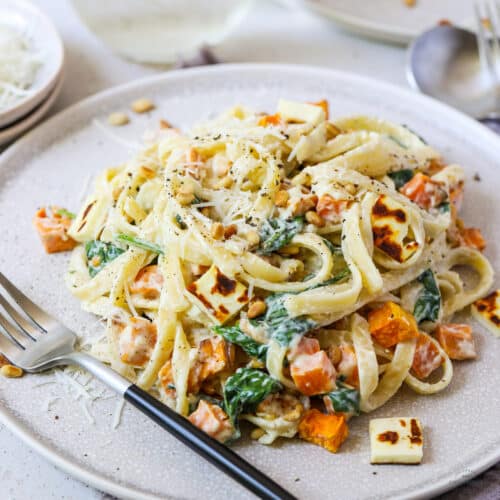
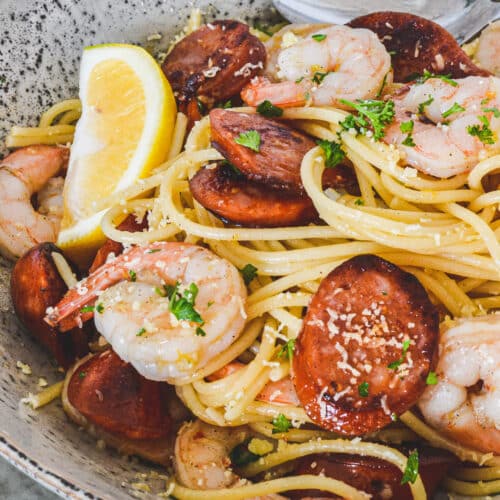
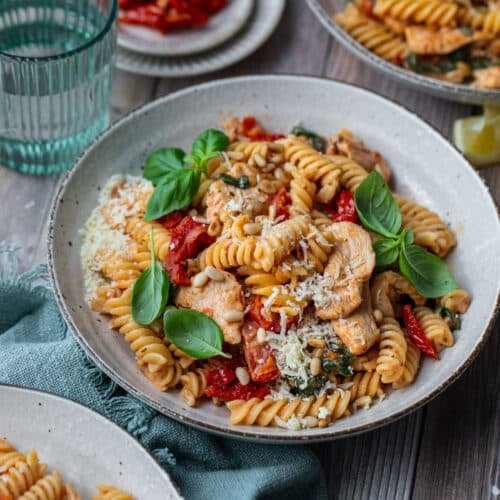
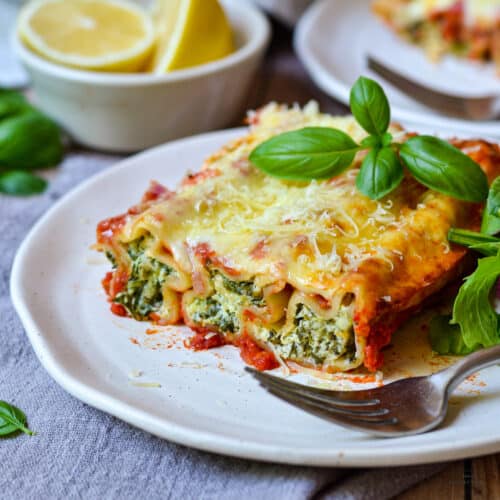

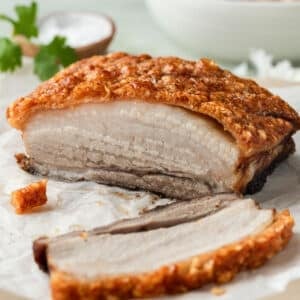

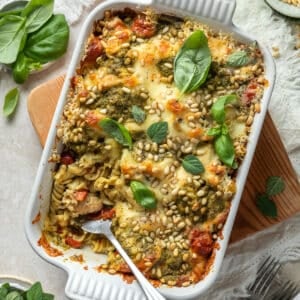
Leave a Reply